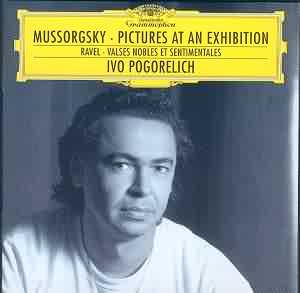
Often, when confronted by performances of familiar repertoire which
differ radically from traditional interpretations, critics suggest that
recordings should avoid incorporating idiosyncrasies which, although
they may have artistic validity within a ‘live’ concert, may
irritate upon repeated hearings. This superbly-engineered CD provides
a good example of why I would suggest that the reverse is more often
the case, in that a listener experiencing these unconventional performances
once only in a concert hall might be so disorientated by their originality
that the overall impression of the playing remaining after the recital
could be one of undisciplined experimentation, whereas the opportunity
to study these interpretations repeatedly via a recording allows one
to adjust to the pianist’s personal approach to the music: not
all musical compositions can be appreciated fully on first hearing,
and neither can all performances.
Pogorelich has already given us an astounding version
of Gaspard de la Nuit on CD. In his reflective and meditative
approach to Valses Nobles et Sentimentales, the deserted-ballroom
atmosphere of the eighth waltz is extended backwards to infiltrate the
mood of most of the preceding seven. The unsynchronised chords and rubato
of the first waltz remain distracting to me even after repeated hearings
(throughout the cycle, Artur Rubinstein’s direct yet sensitive
recording on RCA demonstrates that it is not necessary to distort the
waltz rhythm so fussily in order to characterise the music) but elsewhere
one senses that every chordal balance and gradation of phrase has been
selected after meticulous consideration in this unusually nostalgic
and brooding vision of Ravel’s work. One should not attach too
much importance to Pogorelich’s liberties with dynamics and tempi,
as the editions always used for recordings of Ravel’s piano music
are themselves not entirely faithful to the composer’s intentions
anyway: it is a pity that copyright difficulties prevented Peters Edition
from issuing an urtext version of Valses Nobles et Sentimentales
in their excellent newly-edited Ravel series, as bars 31-34 of the fourth
waltz were modified by the composer after publication, yet here, as
always, the standard Durand edition reading of this passage is recorded.
Pogorelich is up to date in his choice of edition for
Pictures at an Exhibition, with many textual details restored
to Mussorgsky’s intentions, of which the loud opening of Bydlo
is only the most obvious. Apart from some discreet reinforcement of
the bass at the climax of The Great Gate of Kiev, this recording
is faithful to Mussorgsky’s keyboard layout although some inspired
changes in dynamic inflections may mislead some listeners into believing
otherwise: ironically, many other artists, whose more bland performances
of the work appear on the surface to be more literal than this one,
alter Mussorgsky’s text freely without acknowledging their own
contributions, assuming that this is justified on the grounds that,
supposedly, the composer did not know how to write idiomatically for
the piano (on the contrary, the testimony of Mussorgsky’s contemporaries
confirms that he was an accomplished pianist).
Small details in Pogorelich’s interpretation leave
me perplexed: the rhythm in Gnomus at 0’19" is so distorted
as to alter the time signature from 3/4 to 4/4; likewise, Samuel
Goldenberg and Schmuyle is played in 12/8 rather than 4/4 at 0’41";
the rubato in The Old Castle is at odds with the deliberate monotony
which Mussorgsky seeks as appropriate to the grey desolation of the
scene being invoked; and the elongated pauses at the start of The
Hut of Baba-Yaga prevent the movement from gaining momentum until
the opening bars are past. Putting caveats aside, one finds major insights
on offer elsewhere, not least the startlingly-effective control of a
dry texture in the middle section of Baba-Yaga at 1’10".
All other performances of Bydlo sound hopelessly superficial next to
Pogorelich’s, which is monumentally lumbering, disintegrating at
the end into a remarkable pianissimo, and the Ballet of the Chickens
in their Shells (with an extra repeat included here which is often
not played) emphasises playfulness rather than the exaggerated ‘humour’
which is so desperately predictable in other performances.
Catacombae forms a well-judged prelude to a profound
realisation of Con mortuis in lingua mortua which has no parallel
in the performing tradition of this movement: the right-hand tremolo
is played as a hypnotic slow oscillation, and the control of nuance
on display throughout this movement will be appreciated particularly
by listeners who are themselves professional pianists. These two pictures
take 7’12" alone and the sense of stillness they produce is so
moving that, as the end of Con mortuis approaches, one wonders
how it will be possible for Pogorelich to continue with the remaining
two pictures at all. He provides a dignified view of The Great Gate
of Kiev: often pianists play this too slowly, forgetting that whilst
such a tempo can be sustained convincingly in the orchestral arrangement
by Ravel, it will not necessarily work well on the piano. Although slow,
Pogorelich’s account of this movement is successful because his
tempo is consistent with his spacious conception of the work as a whole
(over 42 minutes) and because even the simple block textures are nurtured
here with a degree of pianistic refinement which eludes other pianists
who are usually preoccupied, trying to make a simplistic ‘big effect’.
Nevertheless, the bass string rattling noisily on Pogorelich’s
piano at 5’52" indicates the colossal power emanating from the
instrument - genuine power too, rather than standardised ‘virtuoso’
noise.
Readers who believe that there is nothing new to be
discovered about these two frequently-played works should listen to
this CD. Pogorelich is by no means as controversial an artist as he
is portrayed: it is simply that his intellectual awareness leads him
to re-examine established performance traditions, and it is inevitable
that his consequent redefinition of artistic parameters should be regarded
as ‘controversial’ by pedantic commentators to whom the status
quo is sacrosanct. After repeated hearings, positive-minded listeners
are likely to consider these two revelatory performances to be amongst
the most thought-provoking versions ever released on disc.

